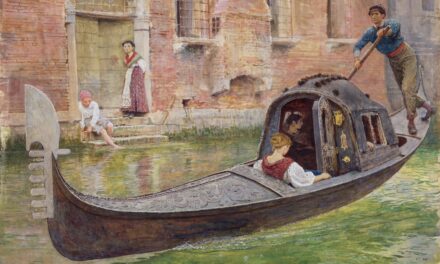The early life of an artist often serves as a foundation for their creative journey, and this is certainly true for Martini. Born in a modest household in the heart of Italy, he was surrounded by the rich tapestry of culture and history that the region offered. From a young age, he exhibited a keen interest in the arts, often found sketching the vibrant landscapes and bustling streets of his hometown.
His parents, recognising his talent, encouraged him to pursue formal education in the arts. This led him to enrol in a prestigious art academy, where he was exposed to a variety of artistic techniques and philosophies. During his formative years at the academy, Martini was influenced by the teachings of renowned artists and scholars.
He immersed himself in the study of classical art, drawing inspiration from the masters of the Renaissance. The rigorous training he received not only honed his technical skills but also instilled in him a deep appreciation for the historical context of art. This period of education was pivotal, as it shaped his understanding of composition, colour theory, and the emotive power of visual storytelling.
Martini’s early experiences laid the groundwork for his future explorations and innovations in the art world.
Summary
- Early Life and Education: Martini was born in Italy in the 14th century and received his artistic training in Siena.
- Style and Influences: Martini’s style was influenced by the Gothic and Byzantine art of his time, and he was known for his delicate and graceful figures.
- Notable Works: Martini’s most famous works include the Maestà and the Annunciation, which showcase his mastery of religious subject matter.
- Legacy and Impact: Martini’s work had a significant impact on the development of Sienese painting and influenced later Renaissance artists.
- Techniques and Materials: Martini was known for his use of vibrant colours, intricate detailing, and the use of gold leaf in his paintings.
Style and Influences
Martini’s artistic style is a unique amalgamation of various influences that reflect both his personal experiences and broader artistic movements. His work is characterised by a vibrant colour palette and dynamic compositions that draw the viewer into a world of emotion and narrative. Influenced by the Baroque period, Martini often employed dramatic contrasts of light and shadow, known as chiaroscuro, to create depth and intensity in his pieces.
This technique not only enhances the visual appeal but also serves to evoke a sense of drama and tension within the artwork. In addition to Baroque influences, Martini was also inspired by the Impressionists, whose emphasis on capturing fleeting moments resonated with his own artistic vision. He admired their ability to convey emotion through colour and brushwork, leading him to experiment with loose brushstrokes and a more spontaneous approach to painting.
This blend of styles resulted in a distinctive aesthetic that set Martini apart from his contemporaries. His ability to synthesise these diverse influences into a cohesive body of work speaks to his innovative spirit and dedication to pushing the boundaries of traditional art forms.
Notable Works
Throughout his career, Martini produced a remarkable array of works that have garnered critical acclaim and captivated audiences worldwide. One of his most celebrated pieces is “The Dance of Life,” a large-scale painting that encapsulates the vibrancy and complexity of human experience. In this work, Martini masterfully intertwines figures in motion, using colour and form to convey a sense of joy and vitality.
The painting not only showcases his technical prowess but also reflects his deep understanding of human emotion and connection. Another notable work is “Reflections on Solitude,” which presents a stark contrast to “The Dance of Life.” In this piece, Martini explores themes of isolation and introspection through a solitary figure set against a haunting landscape. The use of muted tones and soft brushwork creates an atmosphere of melancholy, inviting viewers to engage with their own feelings of solitude.
This duality in his work—balancing exuberance with introspection—demonstrates Martini’s versatility as an artist and his ability to resonate with diverse audiences.
Legacy and Impact
Martini’s impact on the art world extends far beyond his lifetime, as he has inspired countless artists who followed in his footsteps. His innovative techniques and unique style have left an indelible mark on contemporary art, encouraging new generations to explore their own creative voices. Art historians often cite him as a pivotal figure in the evolution of modern painting, particularly for his contributions to colour theory and composition.
Moreover, Martini’s commitment to exploring complex themes within his work has paved the way for artists to address social issues and personal narratives through their art. His ability to weave emotion into visual storytelling has influenced movements such as Expressionism and Surrealism, where artists sought to convey deeper psychological truths through their creations. As such, Martini’s legacy is not merely confined to his own works but continues to resonate within the broader context of art history.
Techniques and Materials
Martini’s approach to techniques and materials was characterised by experimentation and innovation. He was known for his meticulous preparation of surfaces, often employing unconventional materials that added depth and texture to his paintings. His choice of canvas was deliberate; he frequently opted for linen over cotton due to its durability and ability to hold paint more effectively.
This choice allowed him to achieve greater detail and vibrancy in his work. In terms of technique, Martini was particularly adept at layering paint to create luminosity. He often used glazes—thin layers of transparent paint—to build up colour gradually, resulting in a rich visual experience that captivated viewers.
Additionally, he experimented with mixed media, incorporating elements such as gold leaf and natural pigments derived from minerals and plants. This not only enhanced the aesthetic quality of his pieces but also reflected his deep connection to nature and the environment.
Collaborations and Commissions
Throughout his career, Martini engaged in numerous collaborations and commissions that further enriched his artistic practice. He often worked alongside architects and designers on public art projects, where he was able to integrate his vision into larger architectural contexts. One notable collaboration involved creating a series of murals for a prominent civic building, where he infused local history and culture into his designs.
This project not only showcased his versatility but also demonstrated how art can enhance public spaces. In addition to public commissions, Martini collaborated with fellow artists on various exhibitions that celebrated collective creativity. These partnerships allowed him to exchange ideas and techniques with other creatives, fostering an environment of artistic growth.
Such collaborations were instrumental in shaping Martini’s approach to art-making, as they encouraged him to push boundaries and explore new avenues within his practice.
Personal Life and Relationships
Martini’s personal life was as rich and complex as his artistic endeavours. He formed deep connections with fellow artists, writers, and intellectuals who shared his passion for creativity. These relationships often served as sources of inspiration, influencing both his work and personal philosophy.
His friendships with other artists provided a supportive network that encouraged experimentation and dialogue about artistic practices. Romantic relationships also played a significant role in Martini’s life, often serving as muses for his work. He had several passionate liaisons that inspired some of his most poignant pieces, reflecting the interplay between love, loss, and creativity.
These experiences informed not only the themes present in his artwork but also contributed to the emotional depth that characterises much of his oeuvre.
Martini’s Place in Art History
Martini occupies a significant place in art history as a bridge between traditional techniques and modern sensibilities. His ability to synthesise various influences while maintaining a distinct voice has earned him recognition as a pioneering figure in contemporary art. Art historians often highlight how he navigated the transition from classical forms to more expressive styles, paving the way for future movements that sought to challenge conventions.
His contributions extend beyond mere aesthetics; Martini’s exploration of complex themes such as identity, emotion, and social commentary has resonated with audiences across generations. As contemporary artists continue to grapple with similar issues, Martini’s work remains relevant, serving as both inspiration and reference point for those seeking to express their own narratives through art. In this way, Martini’s legacy endures, firmly establishing him as an essential figure in the ongoing dialogue about the role of art in society.
For those interested in exploring different artistic techniques, a related article worth checking out is Combining 3D Elements with Paint: Adding Dimension to Mixed Media. This article delves into the process of incorporating three-dimensional elements into traditional painting, offering a unique way to add depth and texture to artworks. It provides valuable insights for artists looking to experiment with mixed media and push the boundaries of their creative practice.
FAQs
Who is Simone Martini?
Simone Martini was an Italian painter born in 1284 in Siena, Italy. He was a leading figure in the Sienese School of painting and is known for his contributions to the development of the International Gothic style.
What are some of Simone Martini’s most famous works?
Some of Simone Martini’s most famous works include the “Annunciation with St. Margaret and St. Ansanus” in the Uffizi Gallery in Florence, and the “Maestà” in the Palazzo Pubblico in Siena. He is also known for his frescoes in the Lower Church of the Basilica of San Francesco in Assisi.
What is the significance of Simone Martini’s work?
Simone Martini’s work is significant for its influence on the development of the International Gothic style, characterized by its elegant and decorative qualities. His use of vibrant colours, intricate details, and graceful figures set him apart as a master of his craft.
What techniques did Simone Martini use in his paintings?
Simone Martini was known for his use of tempera and gold leaf on panel, as well as his skillful use of perspective and spatial depth. He also incorporated elements of Byzantine and Gothic art into his work, creating a unique and distinctive style.
What is the legacy of Simone Martini?
Simone Martini’s legacy lies in his significant contributions to the development of the International Gothic style and his influence on subsequent generations of artists. His work continues to be admired for its beauty and technical skill, and he is remembered as one of the great masters of Italian painting.


